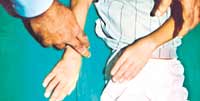| JIA: When
a pain in the joints could be something more
By Ayesha Inoon
Arthritis is a disease that we commonly
associate with the aged. Yet Juvenile Arthritis or Arthritis
which occurs in children before the age of 16 is also
a fairly common condition. For some children Juvenile
Arthritis is fairly mild and doesn't cause a significant
impact on their lives, while for others it can be a
disabling condition with considerable pain and limitations
in mobility and daily activities.
 |
| Dr. Saman Jayanetti |
While there are several different types
of arthritis in children, 'Juvenile Idiopathic Arthritis'
(JIA) is the most common, according to Dr. Saman Jayanetti,
Consultant in Rheumatology and Rehabilitation, Lady
Ridgeway Hospital.
The term 'idiopathic' is used because
there is no underlying demonstrable cause for the disease
- it appears that for some reason the immune system
becomes confused, and releases chemicals which cause
inflammation. Heredity may be a reason, but on its own
it does not seem to cause JIA. The factors that trigger
the disease are unknown.
Arthritis, says Dr. Jayanetti, refers
to inflammation of joints. The main symptoms of JIA
are pain in the joint or joints, difficulty in movement
and sometimes, swelling in and around the joints.
JIA is difficult to diagnose because
its symptoms are easily confused with other illnesses.
However, if a child has persistent pain in the joints
for over 6 weeks, JIA should be suspected, says Dr.
Jayanetti. This is since joint pain that is caused by
viral flu, rheumatic fever or other such illnesses usually
does not last for more than 4-6 weeks.
Also, since the symptoms of Systemic
Arthritis - a particular type of JIA - closely resembles
that of Leukaemia that should first be ruled out, he
adds.
Of course, joint pain does not always
have to mean Arthritis, he says. For instance 'Growing
Pains'-or the pains that occur in the calves and thighs
particularly at night, or 'Hyper Mobility Syndrome'-which
affects any joint that has been overstretched, are also
conditions which arise in growing children.
The good news is that the majority
of children with JIA can be cured if diagnosed early,
and continue to live normal lives. Medications are available
that both decrease the symptoms of joint pain and stiffness
and alter the disease process, preventing permanent
damage to the joint or joints. Appropriate medical therapy
depends on the category of JIA and extent of joint involvement.
 |
| Pix by Athula Devapriya |
Late diagnosis on the other hand, may
lead to deformities in the child's limbs. Another complication
of JIA, says Dr. Jayanetti, is uveitis (or inflammation
of the eyes), which if not diagnosed properly can lead
to blindness or impaired vision.
He also stresses on the importance
of continued treatment by a qualified doctor which can
be from a few months to several years. Special care
should be taken when steroids are indicated for the
treatment of JIA, he says, since these can cause side
effects such as facial and bodily swelling, diabetes,
cataracts, growth retardation and osteoporosis. Steroids
should only be taken for a short period of time.
For some children JIA may be cured
permanently, but for a few there is a chance of recurrence
in adulthood.
JIA is categorized into 5 main types
based on the number of joints involved during the first
6 months of disease and the involvement of other organs.
* Oligoarticular - This is the most
common type of JIA and is defined as the involvement
of fewer than 4 joints. This type often includes uveitis
(inflammation in the eyes).
* Polyarticular - When there is arthritis
in 4 or more joints.
* Systemic arthritis - This is characterized
by high fevers, rash, and inflammation of other organs,
in addition to arthritis.
* Enthesitis related-This involves
pain in the insertion of the ligaments and occurs mainly
in boys older than 8 years.
* Psoriatric arthritis - This includes
children who have arthritis and may develop psoriasis
rashes later on.
|
